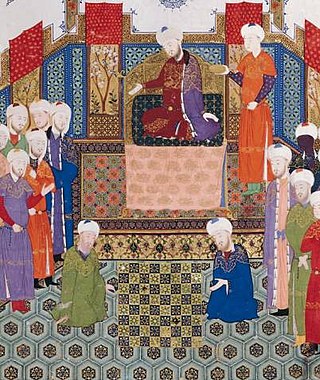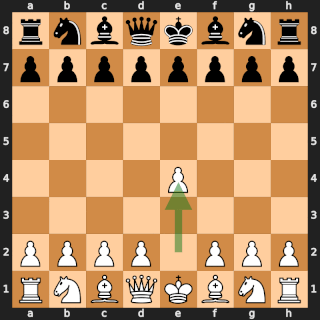
Chess is a board game between two players. It is sometimes called international chess or Western chess to distinguish it from related games, such as xiangqi and shogi. The current form of the game emerged in Spain and the rest of Southern Europe during the second half of the 15th century after evolving from chaturanga, a similar but much older game of Indian origin. Today, chess is one of the world's most popular games, played by millions of people worldwide.

The knight is a piece in the game of chess, represented by a horse's head and neck. It moves two squares vertically and one square horizontally, or two squares horizontally and one square vertically, jumping over other pieces. Each player starts the game with two knights on the b- and g-files, each located between a rook and a bishop.

Shatranj is an old form of chess, as played in the Sasanian Empire. Its origins are in the Indian game of chaturaṅga. Modern chess gradually developed from this game, as it was introduced to Europe by contacts in Muslim Al-Andalus and in Sicily in the 10th century.

A chess problem, also called a chess composition, is a puzzle set by the composer using chess pieces on a chess board, which presents the solver with a particular task. For instance, a position may be given with the instruction that White is to move first, and checkmate Black in two moves against any possible defence. A chess problem fundamentally differs from over-the-board play in that the latter involves a struggle between Black and White, whereas the former involves a competition between the composer and the solver. Most positions which occur in a chess problem are 'unrealistic' in the sense that they are very unlikely to occur in over-the-board play. There is a good deal of specialized jargon used in connection with chess problems.
This glossary of chess explains commonly used terms in chess, in alphabetical order. Some of these terms have their own pages, like fork and pin. For a list of unorthodox chess pieces, see Fairy chess piece; for a list of terms specific to chess problems, see Glossary of chess problems; for a list of named opening lines, see List of chess openings; for a list of chess-related games, see List of chess variants; for a list of terms general to board games, see Glossary of board games.

Mikhail Nekhemyevich Tal was a Soviet-Latvian chess player and the eighth World Chess Champion. He is considered a creative genius and is widely regarded as one of the most influential chess players. Tal played in an attacking and daring combinatorial style. His play was known above all for improvisation and unpredictability. Vladislav Zubok said of him, "Every game for him was as inimitable and invaluable as a poem".
This glossary of chess problems explains commonly used terms in chess problems, in alphabetical order. For a list of unorthodox pieces used in chess problems, see Fairy chess piece; for a list of terms used in chess is general, see Glossary of chess; for a list of chess-related games, see List of chess variants.

The Immortal Game was a chess game played by Adolf Anderssen and Lionel Kieseritzky on 21 June 1851 in London, during a break of the first international tournament. The bold sacrifices Anderssen made have made it one of the most famous chess games of all time. Anderssen gave up both rooks and a bishop, then his queen, checkmating his opponent with his three remaining minor pieces. In 1996, Bill Hartston called the game an achievement "perhaps unparalleled in chess literature".

The Opera Game was an 1858 chess game, played at an opera house in Paris. The American master Paul Morphy played against two strong amateurs: the German noble Karl II, Duke of Brunswick, and the French aristocrat Comte Isouard de Vauvenargues. It was played as a consultation game, with Duke Karl and Count Isouard jointly deciding each move for the black pieces, while Morphy controlled the white pieces by himself. The game was played in a box while an opera was performed on stage. Morphy quickly checkmated his opponents following rapid development of material, involving a queen sacrifice.

Checkmate is any game position in chess and other chess-like games in which a player's king is in check and there is no possible escape. Checkmating the opponent wins the game.

John Denis Martin Nunn is an English chess grandmaster, a three-time world champion in chess problem solving, a chess writer and publisher, and a mathematician. He is one of England's strongest chess players and was formerly in the world's top ten.
In chess, the scholar's mate is the checkmate achieved by the following moves, or similar:
The Alekhine's Defence is a chess opening that begins with the moves:
The two knights endgame is a chess endgame with a king and two knights versus a king. In contrast to a king and two bishops, or a bishop and a knight, a king and two knights cannot force checkmate against a lone king. Although there are checkmate positions, a king and two knights cannot force them against proper, relatively easy defense.
In chess, a pure mate is a checkmate position such that the mated king is attacked exactly once, and prevented from moving to any of the adjacent squares in its field for exactly one reason per square. Each of the squares in the mated king's field is attacked or "guarded" by one—and only one—attacking unit, or else a square which is not attacked is occupied by a friendly unit, a unit of the same color as the mated king. Some authors allow that special situations involving double check or pins may also be considered as pure mate.
Christopher Geoffrey Ward is a British chess Grandmaster (GM), chess coach, and author. He grew up in North West Kent, on the edge of Vigo Village and played his early chess at the village school chess club.
In chess endgames with a bishop, a pawn that is a rook pawn may be the wrong rook pawn. With a single bishop, the result of a position may depend on whether or not the bishop controls the square on the chessboard on which the pawn would promote. Since a side's rook pawns promote on opposite-colored squares, one of them may be the "wrong rook pawn". This situation is also known as having the wrong-colored bishop or wrong bishop, i.e. the bishop is on the wrong colored squares in relation to the rook pawn. In many cases, the wrong rook pawn will only draw, when any other pawn would win. A fairly common defensive tactic is to get into one of these drawn endgames, often through a sacrifice.

In chess, several checkmate patterns occur frequently enough to have acquired specific names in chess commentary. By definition, a checkmate pattern is a recognizable/particular/studied arrangements of pieces that delivers checkmate. The diagrams that follow show these checkmates with White checkmating Black.

The following outline is provided as an overview of and topical guide to chess:
In chess, an economical mate is a checkmate position such that all of the attacker's remaining knights, bishops, rooks and queens contribute to the mating attack. The attacker's king and pawns may also contribute to the mate, but their assistance is not required, nor does it disqualify the position from being an economical mate. Economical mates are of interest to chess problem composers for their aesthetic value. In real gameplay, their occurrence is incidental. Nevertheless, some notable games have concluded with an economical mate such as the Opera game, won by Paul Morphy.










